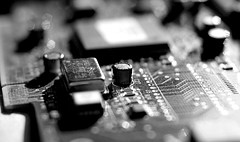
From what I’ve read, bending capacitors of this magnitude might blow your fingers off. Or at minimum, learn you real quick never do that again.
Love noise? Love toys? Perhaps circuit bending is for you./
To celebrate Thumbuki’s soft launch, we’re kicking off our our first original series: Get Bent
And by original series, I mean I’m personally going to be doing research on “circuit bending” over the next few weeks, and sharing my findings with you. I will post here the top relevant links, video, tutorials, historical accounts, etc, as I find them.
What is circuit bending? According to wikipedia:
“Circuit bending is the creative short-circuiting of low voltage, battery-powered electronic audio devices such as guitar effects, children’s toys and small synthesizers to create new musical instruments and sound generators. “
Also check out this video example of circuit bending by James Anderson.
As for me, I have zero hands-on experience with electronics. Though I do have some familiarity with everything from modular synthesizers to Csound. So I plan on getting very used to the idea of holding a soldering iron in the near future. I will be reporting back to you all of my successes and all of my failures as I turn children toys into little electronic frankensteins. For art’s sake.



